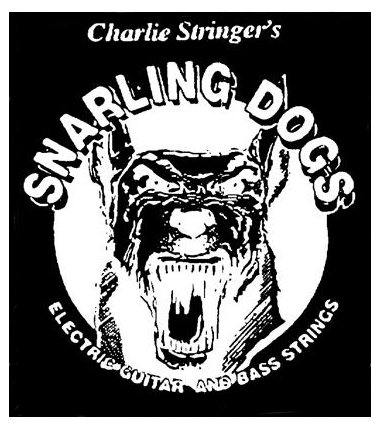 A little about guitar strings. For a few years I had the late Charlie Stringer for a customer. I designed his (charmingly) objectionable full-page ads in Guitar Player magazine. As an aside, Charlies was banned from advertising in Guitar Player magazine for life – twice. Miss you, dude.). I made packaging for his pedals and effects, a ton of string packages for Snarling Dogs brand and a handful of his other branded guitar strings. Back then there were plenty of choices for strings but today that number is exponentially larger… there are a LOT of string choices! Different materials, treatments and gauges (thickness) a starting guitarist can get pretty overwhelmed. Also, frankly, so a guy who’s been at it for a while. Here are some thoughts that might make choosing a little easier, or at least, get you out of the weeds a little.
A little about guitar strings. For a few years I had the late Charlie Stringer for a customer. I designed his (charmingly) objectionable full-page ads in Guitar Player magazine. As an aside, Charlies was banned from advertising in Guitar Player magazine for life – twice. Miss you, dude.). I made packaging for his pedals and effects, a ton of string packages for Snarling Dogs brand and a handful of his other branded guitar strings. Back then there were plenty of choices for strings but today that number is exponentially larger… there are a LOT of string choices! Different materials, treatments and gauges (thickness) a starting guitarist can get pretty overwhelmed. Also, frankly, so a guy who’s been at it for a while. Here are some thoughts that might make choosing a little easier, or at least, get you out of the weeds a little.
“Gauge” refers to the string’s physical thickness.
A good place to start gauge-wise for 6-string electric is .010–.046 , referred to as”tens”. Most solid body electrics come strung with “ tens” or the slightly lighter gauged “nines” (.009 – .042) . The .010 gauge string is the small E string and the .046 is the sixth string (E). The other strings are gauged accordingly for an even tension, feel and sound. In standard tuning—E, B, G, D, A, E— on a standard guitar, these gauges offer a balance between good tone and “playability” which to me means, how easy they are to press down on frets or how easy they are to bend. Lighter strings will naturally be a little easier to play. The thinner the string, the less tension, and consequently it takes less effort to push down on the frets as well as bending the string. A lighter gauge string will not have as “full” a tone as heavier gauges though. Strings with a lighter gauge are going to have a brighter tone; heavier strings are going to sustain better when you’re playing hard. There are lots of options to choose from, so it’s worth taking the time to try different gauges. A lighter string is easier on your hands, too.
Going up to in gauge to elevens ( .011–.048), the strings have greater tension which allows you to play harder but they’re also harder to bend and fret. This gauge set offers the option of a third string that is either plain or with windings like the 4th, 5th, and 6th strings. The wound 3rd string is darker sounding and much more difficult to bend, changing the entire tonal complexion of the guitar. Typically, a heavier string offers a darker tone than a lighter gauge string of similar materials. Heavier string gauges are also more useful for drop-tunings, slide guitar and alternate tunings due to the increased tension. Gauges above .011 are usually used for either extra-low tunings or on jazz guitars for their warmer tone, although Stevie Ray Vaughan used .013s! Here’s a pretty good article on the subject
For electric guitars, flat-wound strings offer the most dramatically different sound and feel. Compared to most strings, which are round-wound, flat-wound strings have an extra layer of ribbon winding that is polished, resulting in a very smooth, mellow tone. Traditional jazz guitar tone is most associated with flat-wound strings, but they also work well for non-jazz finger-style guitar playing. The smooth surface decreases finger noise and though flat-wound strings don’t bend easily, that style of playing doesn’t call for bends much anyway.
You can ( but I don’t recommend it) put nylon strings on your acoustic guitar. They can’t vibrate the top like steel strings so I’ll bet you find that the sound is kind of disappointing. They can move it a little, obviously but the acoustic guitar top is stiffer than a classical guitar top- really, acoustic guitars are meant to be used with steel strings. which provide the tension necessary to move the top properly. NEVER put steel strings on a guitar designed for nylon strings. That will do serious damage to the instrument. A few manufacturers make a hybrid electric/acoustic guitar, Washburn for one. They look and play like an acoustic guitar but strung with nylon strings, and have a piezo pickup to boost the sound. Try one out if you get a chance. And nylon string electric guitars like the Godin Multiac are worth looking at too, while you’re out getting your strings.
Remember that what strings you use is an entirely personal choice. You should experiment to see what works best for you, your style and your sound. And it’s worth noting in closing that when my professional guitar-playing friend and teacher John LaGreca is asked “what kind of string do you like”, his answer is “whatever’s on sale”!
